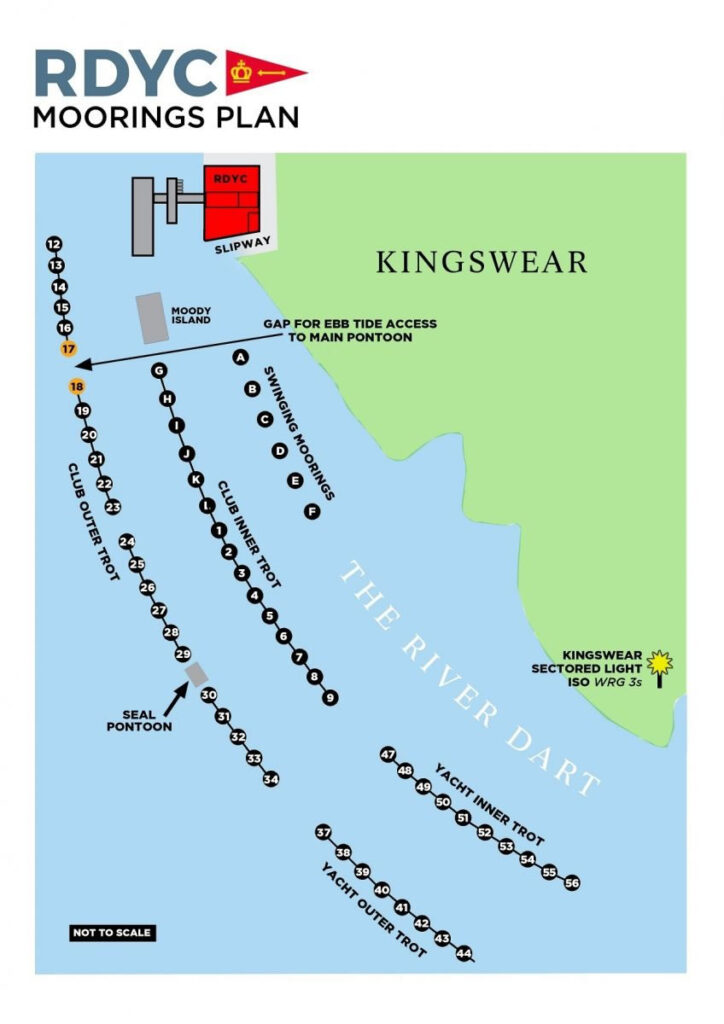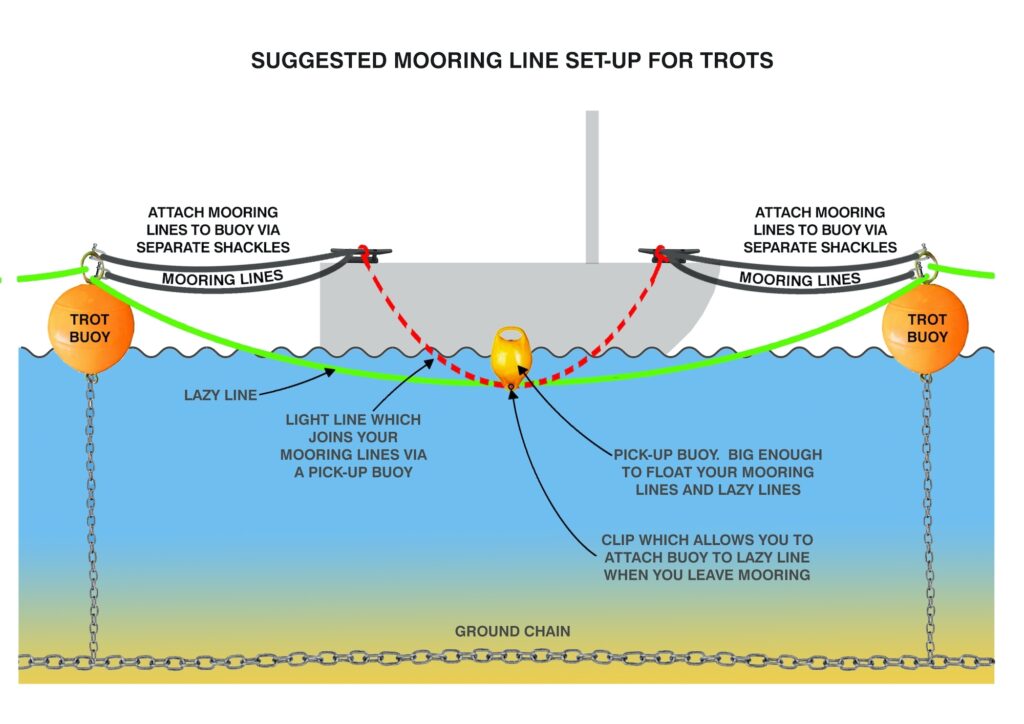
We have a range of moorings on the river Dart available exclusively to club members.
Our Moorings
Situated on the eastern side near the mouth of the river the Club has highly convenient access the sailing in Start bay and beyond. It has its own pontoons and trot moorings for members which run from the Clubhouse down the eastern shore towards the sea.
There are over fifty moorings, which can take boats up to 12 metres LOA, pontoon storage for inflatable tenders, paddle boards and small kayaks and a Bosuns store for the keeping small outboard motors and oars.
All these facilities are available exclusively for members and can be rented on an annual basis.
To apply for a mooring, or tender, outboard or paddle board storage, download the application form here
Guidance for users of moorings and storage facilities
CHARGES – RDYC & DHNA
Harbour Dues are payable on all boats, except Bona Fide Tenders (BFT) or rowing boats of < 3m LOA. Tenders are defined as dinghies whose LOA is ≤ 4.3 metres and have a parent boat moored on the Dart. Tenders must be clearly identified with “TT (boat name)” and also display a DHNA tender sticker. If your parent boat is on an RDYC mooring, we will supply a free tender sticker with the parent boat sticker. If your parent boat is moored elsewhere on the Dart, you need to obtain your tender sticker from the DHNA.
MEASUREMENT OF BOAT
Mooring fees and DHNA dues are based on boat length. Please record your LOA, including all fore and aft projections such as bowsprit, pulpit, pushpit, davits, bumkins, rudder and outboard motors etc., measured in metres and rounded up to the nearest 0.1 metre.
COST CALCULATION
To calculate the Mooring fee and Harbour dues the LOA is rounded up to the nearest 0.5 metre. This rounded up figure is the “chargeable length” and is multiplied by the appropriate rate.
REFUND OF RDYC CHARGES
Should you decide not to use an allocated and paid for facility or mooring, a refund less an administration charge will only be made when Club moorings are full and your vacated berth is re-let.
NAMING AND IDENTIFICATION OF BOATS
All boats must be clearly named and display a DHNA sticker. On a tender or dinghy it is very helpful if the name and sticker are visible in the stored position. Unidentifiable boats may be assumed to be trespassers and could be removed, incurring a return forfeit.
MOORINGS
Yachts are allocated to the Yacht Inner and Yacht Outer trots according to size. Squibs are allocated to Club Outer trots and small keel boats and launches to Club Inner trot. Where possible, identical or similar boats are kept together. There are a number of swinging moorings close to the club which can dry out at spring tides, these are generally suitable for dories and dinghies.
If you are applying for a trot mooring you must appoint an agent. This should be a locally based person who can be contacted by telephone, who will deal with any problem relating to your boat. You can appoint the RDYC as your agent – in which case the Bosun will deal with any problems and you will be liable to reimburse the Club for any costs it incurs.
Coloured polypropylene lazylines are set up by RDYC between all buoys. Please ensure when your mooring warps are taking the load, that the lazyline is just slack and laid along the deck or through loops to avoid chafing, so that the hull can move fore and aft along the line. If your mooring warps are too tight they will induce too much slack in the lazyline. This puts unnecessary strain on the ground tackle and the deck gear of your boat and the adjacent boats. Make sure also that the lazyline never takes the load of mooring the boat. Its’ purpose is to maintain the correct distance between buoys when your vessel is away from your mooring.
Please do not change the length of lazy lines as set up. Your warps need to be made to fit the space allocated. The tidal stream of the river can make behaviour of the boats on our trots quite erratic and if you have concerns the Club Bosun will always assist you. You can contact him through the office.
Warps should be attached to the buoy ring with large galvanized shackles. The Club recommends the use of stranded nylon or polyester, 16mm to 18mm for yachts and 12mm to 16mm for smaller keel boats and launches. There should be two warps to the bow and two warps to the stern, protected against chafing where necessary.
All lines should be checked regularly. Should your lazyline break or have to be cut, please advise the office, the Club will replace it. If you need to vacate your berth when it has no proper lazyline, you should fit a temporary one.
In order to reduce the risk to other boats, outboard engines which are raised clear of the water should have their propellers protected.
DINGHY / TENDER / PADDLEBOARD STORAGE.
We can accommodate up to 36 inflatables and small slim rigid boats in the pontoon rack, where the slot width is approximately 46cm (18 inches). As of 2019 we are also offering storage for paddleboards in the pontoon rack. This is an experiment but will become permanent subject to there being no unforeseen problems.
Dinghies must be lashed securely using the painter or other ties and inflatables must be kept fully inflated. Dinghies which are constantly deflating are a nuisance to other users and may be removed from the rack.
BOSUN’S STORE.
Outboard motors ashore must only be kept in the allocated racks. Fuel cans must never be left in the Bosun’s locker nor on the Club Terrace (this is a condition imposed by our insurers).
SAILING DINGHIES.
The dinghies must be secured in their pontoon rack and have their name clearly displayed. Junior sailing equipment stored in the Bosun’s locker must be kept tidily in the racks and lockers provided. Moody Island is reserved for Club owned boats.
AVAILABILITY OF FACILITIES.
Club moorings are available from the first of April until the end of October. The main pontoon and Moody Island are normally removed before the end of October because of the risk of storm damage and tidal window within which they can be moved.
INSURANCE.
It is a DHNA requirement that all vessels moored on Club moorings be covered by a minimum indemnity of £3,000,000 against costs of recovery or removal in the event of sinking and other damages. It is the owner’s responsibility to ensure there is insurance in place at all times and the owner must sign a declaration to this effect on the Moorings Application Form.

